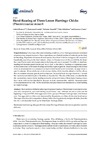Please use this identifier to cite or link to this item:
https://accedacris.ulpgc.es/handle/10553/73935
| DC Field | Value | Language |
|---|---|---|
| dc.contributor.author | Fiorucci, Letizia | en_US |
| dc.contributor.author | Grande, Francesco | en_US |
| dc.contributor.author | Macrelli, Roberto | en_US |
| dc.contributor.author | Schnitzer, Petra | en_US |
| dc.contributor.author | Crosta, Lorenzo | en_US |
| dc.date.accessioned | 2020-08-03T10:34:24Z | - |
| dc.date.available | 2020-08-03T10:34:24Z | - |
| dc.date.issued | 2020 | en_US |
| dc.identifier.issn | 2076-2615 | en_US |
| dc.identifier.other | Scopus | - |
| dc.identifier.uri | https://accedacris.ulpgc.es/handle/10553/73935 | - |
| dc.description.abstract | There are few published studies regarding lesser flamingo (Phoeniconaias minor) reproduction, crop milk composition, and hand-rearing under human care. Between the end of June and the beginning of August of 2017, three eggs were laid in a group of 29 lesser flamingos kept under human care. Two eggs and one chick were abandoned by the parents, and three chicks were handreared. This report describes diet composition, dietary intake, feeding protocols, and growth index, from the first day to 60 days after hatching, for three lesser flamingo chicks. | en_US |
| dc.language | eng | en_US |
| dc.relation.ispartof | Animals | en_US |
| dc.source | Animals [EISSN 2076-2615], v. 10 (8), 1251, (Agosto 2020) | en_US |
| dc.subject | 310907 Patología | en_US |
| dc.subject | 3105 Peces y fauna silvestre | en_US |
| dc.subject.other | Diet | en_US |
| dc.subject.other | Growth Index | en_US |
| dc.subject.other | Hand-Rearing | en_US |
| dc.subject.other | Lesser Flamingo (Phoeniconaias Minor) | en_US |
| dc.subject.other | Spirulina (Spirulina Platensis) | en_US |
| dc.title | Hand-rearing of three lesser flamingo chicks (Phoeniconaias minor) | en_US |
| dc.type | info:eu-repo/semantics/Article | en_US |
| dc.type | Article | en_US |
| dc.identifier.doi | 10.3390/ani10081251 | en_US |
| dc.identifier.scopus | 85088572010 | - |
| dc.contributor.authorscopusid | 57103294400 | - |
| dc.contributor.authorscopusid | 57103030500 | - |
| dc.contributor.authorscopusid | 57103699700 | - |
| dc.contributor.authorscopusid | 57218282908 | - |
| dc.contributor.authorscopusid | 6602582801 | - |
| dc.identifier.eissn | 2076-2615 | - |
| dc.description.lastpage | 7 | en_US |
| dc.identifier.issue | 8 | - |
| dc.description.firstpage | 1 | en_US |
| dc.relation.volume | 10 | en_US |
| dc.investigacion | Ciencias de la Salud | en_US |
| dc.type2 | Artículo | en_US |
| dc.description.notas | This article belongs to the Special Issue The Animal–Human Interfaces in Physiology of Reproduction: The Research to Improve Performance, as well as Animal and Human Health | en_US |
| dc.utils.revision | Sí | en_US |
| dc.date.coverdate | Agosto 2020 | en_US |
| dc.identifier.ulpgc | Sí | es |
| dc.description.sjr | 0,584 | |
| dc.description.jcr | 2,752 | |
| dc.description.sjrq | Q1 | |
| dc.description.jcrq | Q1 | |
| dc.description.scie | SCIE | |
| item.fulltext | Con texto completo | - |
| item.grantfulltext | open | - |
| Appears in Collections: | Artículos | |
SCOPUSTM
Citations
2
checked on Jun 8, 2025
WEB OF SCIENCETM
Citations
2
checked on Jun 8, 2025
Page view(s)
117
checked on May 18, 2024
Download(s)
100
checked on May 18, 2024
Google ScholarTM
Check
Altmetric
Share
Export metadata
Items in accedaCRIS are protected by copyright, with all rights reserved, unless otherwise indicated.
